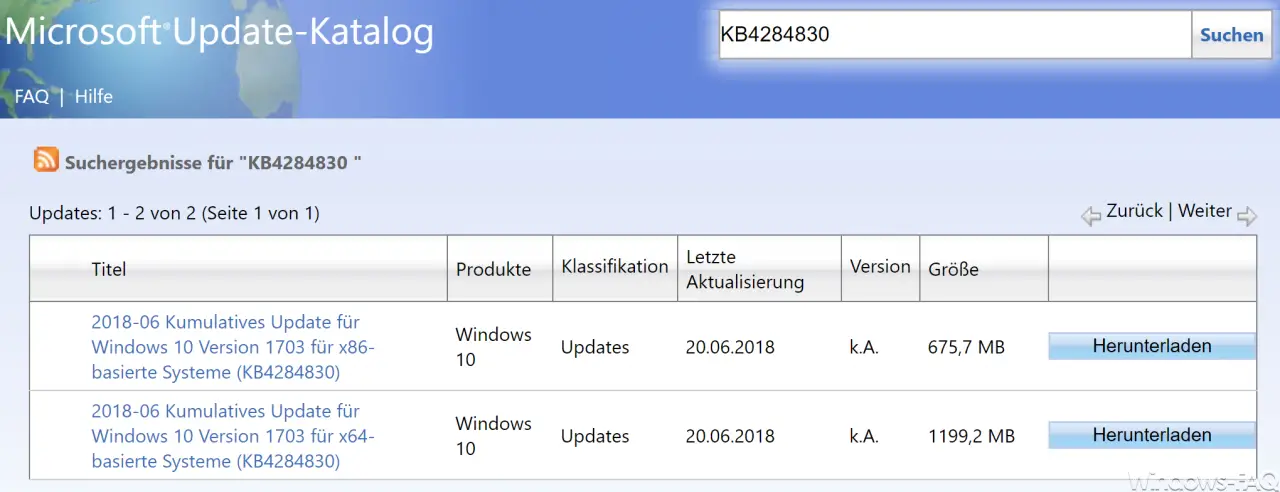Microsoft has recently released two new cumulative Windows updates for Windows 10 without prior notice. On the one hand this is the update KB4284822 Fall Creators Update Version 1709 and the update KB4284830 for Windows 10 Creators Update Version 1703 .
After installing the 1709 update KB4284830, the Windows build number increases to 16299.522 and for Windows 10 version 1703 to 15063.1182 .
Microsoft has previously released the following information about the two updates:
Changes to KB4284822 build 16299.522
- Previously, application performance in operating system functions could deteriorate. This degradation locks and unlocks large blocks of memory (e.g., VirtualLock and Heapfree) after KB4056892 is installed and fixes are replaced.
- The update fixes a performance regression in App-V that slows down many actions in Windows 10.
- It adds a new MDM policy, DisallowCloudNotification , that companies can use to disable Windows notification traffic.
- It changes the music metadata service provider used by Windows Media Player.
- Resolves an issue with placing text symbols in right-to-left languages.
- Addresses an issue when editing web password fields with a touch keyboard .
- The update adds a group policy that can be used to hide recently added apps from the Start menu.
- It updates the ” Segoe UI Emoji ” font to use a water gun for a pistol emoji .
- Addresses a reliability issue when resuming from hibernation.
- Resolves issues where SmartHeap does not work with UCRT.
- Addresses an issue to ensure that Windows Defender Application Guard endpoint functionality complies with regional guidelines.
- It increases the minimum length of the user account in Group Policy from 14 to 20 characters.
- Addresses an issue that causes sporadic authentication problems when using Windows Authentication Manager.
- The update addresses an issue where an Azure Active Directory account domain change prevents customers from signing in.
- Resolves an issue where the messages “Require credentials” and “Do you want to allow the app to access your private key?” Do not appear. This issue occurs when a Universal Windows Platform (UWP) application is running.
- Fixed an issue that could cause the LSASS service to stop responding and restart the system to restore.
- Addresses an issue in which client applications running on a container image do not match the dynamic port range.
- Adds a new registry key that prevents access to the Internet using WWAN when a non-routable Ethernet is connected. To use this new registry key, add IgnoreNonRoutableEthernet “(Dword) under HKEY_LOCAL_MACHINE Software Microsoft Wcmsvc using regedit and set it to 1.
- It adds another new registry key that allows customers to control Internet access using WWAN without using the standard connection manager. To use this new registry key, fMinimizeConnections “(Dword) under HKEY_LOCAL_MACHINE Software Microsoft Windows WcmSvc Local with regedit and set it to 0.
- Resolves an issue that prevented ISO / DVD mounts and emotions from working with VM settings and powershell due to problems with menu transition in VMConnect.
- Resolves the issue where restarting the Hyper-V host with the Hyper-V Replica (HVR) enabled can cause replication to stop. It may also require a manual restart to continue replication from a suspended state. The replication status should be normal after the Hyper-V host / VMMS is restarted.
- Addresses an issue that could cause the client-side extension of mitigation options to fail during GPO processing. The possible errors are “Windows could not apply the settings of” MitigationOptions “. The MitigationOptions settings may have returned their own log file “or” ProcessGPOList: Extension MitigationOptions 0xea. “This issue occurs when mitigation options are defined using Group Policy, Windows Defender Security Center, or the PowerShell Set ProcessMitigation cmdlet.
- Addresses an issue that results in a connection failure if a remote desktop connection does not read the bypass list for a multi-entry proxy.
- The update fixes an issue in which the Windows Defender Security Center and the Firewall Pillar app no longer work when opened. This is caused by a race condition that occurs when third-party antivirus software is installed.
- And it fixes a problem in which task scheduler tasks configured with an S4U login fail with the error ” ERROR_NO_SUCH_LOGON_SESSION / STATUS_NO_TRUST_SAM_ACCOUNT “.

Changes in update KB4284830 for 1703:
- This update also fixes some bugs of the update KB4284830 , which we have explained above. Therefore, we have listed these bug fixes again with this update.
- It fixes a problem with the soft keyboard input modes in WPF applications.
- Resolves an issue where SmartHeap does not work with UCRT.
- Resolves the issue that causes sporadic authentication problems when using Windows Authentication Manager .
- Addresses an issue in MSXML 3.0 that causes the body of the request to be empty when the IXMLHTTPRequest send () method is called. This problem occurs when URL redirection causes the send () method to be called a second time with a different URL.
You can download both updates directly here below:
– 2018-06 Cumulative Update for Windows 10 Version 1709 for x64-based Systems (KB4284822)
– 2018-06 Cumulative Update for Windows 10 Version 1709 for x86-based Systems (KB4284822)
– 2018-06 Cumulative Update for Windows Server 2016 (1709 ) (KB4284822)
– 2018-06 Cumulative Update for Windows 10 Version 1703 for x64-based Systems (KB4284830)
– 2018-06 Cumulative Update for Windows 10 Version 1703 for x86-based Systems (KB4284830)